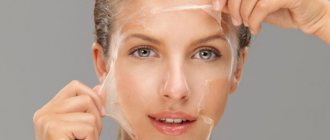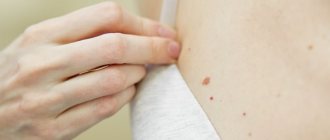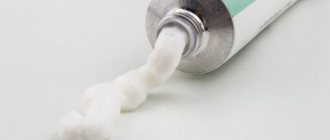Pregnancy is a complete restructuring of a woman’s body. Severe hormonal disruptions occur, internal organs begin to work according to a new “schedule”. All this invariably affects the condition of the expectant mother. Often the color of the skin changes - this is called pigmentation. Why pigment spots appear during pregnancy and how to deal with them, we will tell you in this article.
Pigmentation - what is it?
Pigmentation refers to either darkening or lightening of certain areas of the skin. These processes may occur due to strong melanin production. Melanin is responsible for the color of the skin. What kind of spots will be - dark or light - determines the color of the skin of the expectant mother. Typically, blondes face dark spots, and brown-haired women face light spots.
During pregnancy, age spots often appear on the forehead, inner thighs, belly and breast halos. The strongest pigmentation occurs in the third trimester. On the abdomen, the discoloration takes the form of a brown stripe extending from the navel to the pubis. The nipples take on a dark brown color. This is often noticeable after childbirth.
Typically, during pigmentation, the spots have a ragged shape and a brown tone. If a woman is prone to the appearance of freckles, then they will appear quite strongly during pregnancy.
Contact Information
With the onset of pregnancy, a woman expects many changes: restructuring of the functioning of all internal organs, hormonal imbalance. This affects the physiological and emotional state of the pregnant woman. You can often notice that in certain areas the skin changes color.
Pigmentation: what is it?
Pigmentation appears due to excessive production of melanin, which is responsible for skin color. Pigmentation manifests itself in lightening or darkening of areas of the skin, it all depends on the color of the skin of the expectant mother. More often, owners of dark skin have light spots, and light-skinned people, on the contrary.
Spots appear on the cheeks, on the chin, on the forehead, on the halos of the mammary glands, on the inside of the thighs, on the stomach. Pigmentation is most often noticeable in the third trimester.
A brown stripe appears on the abdomen in the area of the Alba stripe, and the nipples become dark brown.
If age spots are concentrated on the face, they have an irregular shape and are brown in color. Sometimes they appear as an arch from temple to temple across the forehead. This manifestation is called the “pregnant mask”. Pigmentation increases during pregnancy in those who are prone to freckles.
Causes of pigmentation
It is often said that if a woman has pigmentation during pregnancy, she is expecting a girl. In fact, this statement does not have any scientific explanation.
The main cause of age spots is hormonal imbalance, which cannot be avoided.
Genetics can also influence the occurrence of pigmentation on the abdomen, face and nipples. If your mother suffered from pigmentation during pregnancy, you are also at risk.
The cause may be stress, it negatively affects the body of mother and baby, and can cause pigmentation.
Lack of folic acid is another cause of pigmentation. Therefore, doctors recommend consuming folic acid and foods that contain it from the first day of pregnancy. This does not mean that as soon as you notice age spots, you need to start taking vitamins; you should first consult your doctor.
How to get rid of age spots
Don't be upset about pigmentation, this is a temporary phenomenon. Over time, after pregnancy, within 2-3 months, every woman returns to normal. This applies to both hormonal levels and prenatal weight. This means that the pigmentation will go away.
Pigment spots do not require any intensive treatment. If a woman is very concerned about spots, she is nervous about this, you can try to lighten the darkened areas a little. It will not be possible to get rid of stains completely during pregnancy.
Any cosmetic product used should be used only after consultation with a doctor. After all, any seemingly harmless remedy can cause harm to the baby. If you want to do some cosmetic procedures, you should not go to the first beauty salon you come across, it is better to go to a specialized cosmetology clinic, where you should immediately inform that you are pregnant. A cosmetologist will be able to decide whether you can have this or that procedure.
Folk remedies to combat pigmentation
Almost all folk remedies are safe to combat pigmentation:
- Apply any fermented milk product to pigmented areas for 15 minutes, then rinse with warm water.
- A mask of grated fresh cucumber will help lighten blemishes, nourish and refresh the skin.
- Parsley chopped in a blender as a compress will help lighten stains.
- Grapefruit juice, if you are not allergic to citrus fruits, can be applied to the skin for about twenty minutes.
NOT DURING DURING PREGNANCY
apply:
- Laser resurfacing.
- Chemical peeling.
- Products containing excess vitamin A.
- Tanning will only intensify pigment spots, they will become more noticeable and darker.
- Before and during pregnancy, it is necessary to replenish the body with vitamins and spend more time in the fresh air. Good rest, a healthy lifestyle, proper nutrition are the basic requirements for a normal pregnancy.
- A pregnant woman's diet should include a sufficient amount of fruits, vegetables, herbs, cereals, fish and meat. All these products should replenish the body with missing vitamins.
- Direct sunlight should be avoided. If you are often in the sun, use protective body creams.
- Do not use unknown cosmetics.
- Avoid drinking black tea and coffee, but drink enough fluids.
- Avoid stressful situations.
- Visit an endocrinologist to monitor your thyroid function.
How to avoid the appearance of age spots?
- Before and during pregnancy, it is necessary to replenish the body with vitamins and spend more time in the fresh air. Good rest, a healthy lifestyle, proper nutrition are the basic requirements for a normal pregnancy.
- A pregnant woman's diet should include a sufficient amount of fruits, vegetables, herbs, cereals, fish and meat. All these products should replenish the body with missing vitamins.
- Direct sunlight should be avoided. If you are often in the sun, use protective body creams.
- Do not use unknown cosmetics.
- Avoid drinking black tea and coffee, but drink enough fluids.
- Avoid stressful situations.
- Visit an endocrinologist to monitor your thyroid function.
Why do age spots occur?
There is no need to be surprised by age spots. The reason for their appearance is the presence of hormonal imbalance in the body. Without this failure, the implantation of the fetus would not have occurred.
Pigmentation can also be caused by genetics. If your mother developed such age spots during pregnancy, then you will also be at risk.
Another reason for increased pigmentation is stressful situations. Stress always negatively affects the health of the baby and the pregnant woman.
Pregnant women should take folic acid as a dietary supplement from day one. A lack of this vitamin is often the cause of pigmentation. However, there is no need to immediately rely on vitamins at the first age spots - you should first consult a doctor.
Vessels: Chief of the Redskins
Starting from the tenth week of pregnancy, the volume of circulating blood in the body of the expectant mother gradually increases and by the end of the third trimester it increases by 30-40%, and sometimes even more if the baby is large. A serious load falls on the vessels, and not all of them can handle it. The hardest job is on the tiny capillaries located just under the skin. They cannot withstand the pressure of the red liquid, begin to work unstably, and often become clogged and burst. If your vessels are having a hard time, you will immediately know about it. The feet and palms begin to turn red, tiny curved purple capillaries appear on the surface of the skin of the arms and legs, and unsightly spider veins flare up on the face. If such a metamorphosis has happened to you, do not lose heart. Gynecologists claim that such “decorations” appear in approximately 60% of pregnant women.
Redness of the palms and feet is just one of the quirks of pregnancy that will disappear soon after giving birth. But burst capillaries on your face may not leave you for several years, or even your entire life. Fortunately, if the “comrades” who have stayed too long begin to become an eyesore and spoil your mood, you can get rid of them with a laser in just one or two procedures. But keep in mind that this manipulation can only be carried out after the baby is born. For now, just mask the burst blood vessels with cosmetics.
How long will it take for age spots to disappear?
Any changes associated with pregnancy are temporary for the female body. This also includes pigmentation. Gradually the weight before childbirth, abdominal muscles, and hormonal levels return. Within 2-3 months after birth, age spots disappear.
During pregnancy, you don’t have to fight them. They will disappear later anyway. If pigment spots remain, which is relatively rare, then in this case it will be possible to use cosmetology methods.
It is unlikely that pigment spots can be completely removed during pregnancy. You can only lighten the dark areas a little. All your decisions must be agreed with your doctor. Even the simplest and most harmless drugs can negatively affect the health of the fetus. Therefore, when making an appointment at a beauty salon, be sure to indicate that you are pregnant. Absolutely all masks and products will not suit you.
You cannot use chemical peeling, laser resurfacing, or products high in vitamin A. There is a popular myth that tanning helps hide pigmentation. So, let’s dispel this right away: tanning during pregnancy will only further emphasize the presence of age spots.
Acne: ellipsis
In the second trimester of pregnancy, many mothers sadly notice that uninvited guests have appeared on their faces - acne. Even those who previously did not have such problems at all or they happily disappeared along with adolescence are not immune from this trouble. This is due to the increased concentration of testosterone. This male hormone awakens the sebaceous glands from the hibernation into which estrogens plunge them and forces them to work for wear, producing a shock portion of fatty lubricant. Mixing with dust and bacteria living on the skin, the explosive mixture clogs the pores, and nasty pimples crawl to the surface. You need to fight acne with soft cleansing cosmetics that do not contain soap and alcohol. During the day, it is useful to wipe problem skin with antibacterial wipes. But under no circumstances buy remedies for teenage acne: in your situation, they are unsafe and can negatively affect the future toddler, especially if you use them in the first trimester, when the formation of the baby’s vital systems and organs occurs.
How to minimize the risk of age spots during pregnancy
Changes in the body cannot be avoided, but the risks of age spots can be minimized. For a normal pregnancy, it is enough to follow simple rules - adhere to proper nutrition, lead a healthy lifestyle, give up bad habits and give yourself enough rest.
To prevent pigmentation, you can use the following tips:
- The diet should include greens, fruits, vegetables, meat and fish. These products make up for the lack of vitamins.
- Avoid direct sunlight. It is best to purchase sunscreens.
- There is no need to use untested or unknown cosmetics. During pregnancy, not only age spots may appear, but also unusual allergic reactions.
- Drink enough fluids, preferably water.
- Eliminate tea and coffee.
- Eliminate any stress.
- Check your thyroid function. Failures in its activity often lead to the appearance of pigmentation.
Caution - danger!
Soothing Never try to relieve skin irritation with creams and ointments containing cortisone and hydrocortisone. Penetrating through the epidermal barrier, these substances make their way through the bloodstream to the little one and have a negative effect on the fetus. At best, the baby will develop more slowly, at worst, he may develop atrophy of the adrenal cortex. Fighting acne Acne products with isotretinoin, also known as Accutane, retinoic acid and vitamin A, which are often prescribed to teenagers to combat acne, are prohibited for you. These powerful components can cause facial defects, nervous system defects, cleft palate, or even miscarriage in the baby growing in your tummy. Cleansing In your situation, you should not use cleansing cosmetics whose list of ingredients contains salicylic, glycolic, alpha and beta hydroxy acids. Fortunately, they do not have a negative effect on the fetus, but they can seriously injure your skin, which, under the influence of hormones, becomes thinner and becomes very sensitive. There is a chance of irritation, redness and dermatitis.
Spots after childbirth: how to deal with them
Usually pigmentation disappears 2-3 months after birth. The maximum time it can last is about a year. If after a year the areas have not changed at all, then it is best to consult a dermatologist. Perhaps there are some diseases that lead to pigmentation.
If no such diseases are identified, then you can get rid of age spots in beauty salons. The safest methods for removing pigmentation after childbirth are creams and laser.
Sebaceous glands: great dryness
While you are carrying a baby under your heart, the body is actively stocking up on estrogens, which are responsible for the normal course of pregnancy.
And these hormones inhibit the work of the sebaceous glands, which begin to become lazy and produce less secretion. If your skin is naturally oily or problematic, consider yourself lucky, because at least for the next nine months, you can finally forget about greasy shine and annoying pimples. But if you have dry or normal skin, then the period of waiting for the baby will present several unpleasant surprises. The epidermis will become drier, peeling, itching and even allergic rashes may appear on it.
If your skin begins to peel, forget about alcohol lotions and under no circumstances try to remove dead particles with a scrub. This may have the opposite effect. For daily care, use a moisturizer and make nourishing masks every two weeks. Be sure to buy a humidifier or at least regularly wet clean your home. During the heating season, the air in the apartment becomes very dry and unceremoniously draws moisture from already dehydrated skin.
Hyperpigmentation
This is the appearance of dark spots on the face or other parts of the body. The phenomenon is caused by an increase in melanin production and goes away after childbirth, but can persist for several years.
An example of hyperpigmentation during pregnancy is melasma, known as “mask of pregnancy,” which is characterized by brown patches on the face, cheeks, nose, and forehead. To solve this problem, you need to consult a dermatologist.
To reduce stains, it is recommended to follow simple rules:
- limit your stay on the street during the period of solar activity from 10:00 to 14:00;
- in hot weather, use sunscreen with a factor of 30 or higher;
- wear a wide-brimmed hat.
Other skin diseases in pregnant women
Less common skin conditions during pregnancy are pemphigoid rash and intrahepatic cholestasis.
- Gestational pemphigoid rash
is an autoimmune disease that appears in the second or third trimester or after childbirth. Symptoms of this condition include blisters on the abdomen or other parts of the body. Increases the risk of premature birth or having a low birth weight baby. - Intrahepatic cholestasis of pregnancy
is a liver condition that appears in the third trimester. It is characterized by severe itching on the palms of the hands, soles of the feet or torso, and occurs without a rash.
If unusual sensations on the skin, itching or rashes appear, you should consult a doctor to find out the cause of the phenomenon and begin treatment on time.
ONLINE REGISTRATION at the DIANA clinic
You can sign up by calling the toll-free phone number 8-800-707-15-60 or filling out the contact form. In this case, we will contact you ourselves.
Pimples
During pregnancy, hormonal changes occur that lead to acne. There are many ways to treat this problem.
It is necessary to follow general hygiene rules, such as washing your face with warm water and a mild product twice a day, treating the skin with non-aggressive products to prevent clogged pores.
During this period, you can use drugs that include benzoyl peroxide or salicylic, azelaic or glycolic acids.
During pregnancy it is prohibited:
- Carry out hormonal therapy
due to the increased risk of congenital pathologies of the fetus; - Use Isotretinoin
(a form of vitamin A, also known as Retinol). This can lead to disturbances in the mental and physical development of the unborn child. - Use Tetracycline
because it affects the formation of the fetal bone skeleton.
What skin changes can happen?
All physiological changes in the skin during pregnancy are divided into 4 types:
| Type | Possible manifestations |
| Pigment changes | Hyperpigmentation |
| Melasma | |
| Striae | |
| Changes in nails and hair | Telogen effluvium |
| Hirsutism | |
| Nail changes | |
| Vascular changes | Telangiectasia |
| Palmar erythema | |
| Granuloma of pregnancy | |
| Phlebeurysm | |
| Pregnant stripes | |
| Change in gland activity | Changes in the activity of apocrine, eccrine and sebaceous glands |










